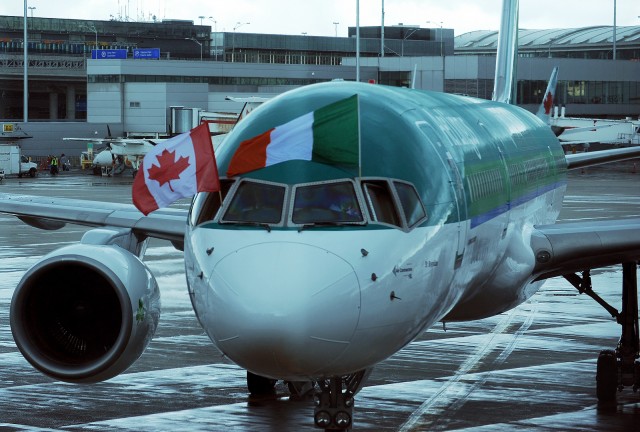
Celebrating Aer Lingus’ return to Toronto – Photo: Philip Debski
Back on April 14, 2014, Aer Lingus officially launched its comeback to Canada. That Monday was dark and wet, with pouring rain, when flight ‘Shamrock 1 Mike 9’ (129 in the reservation system) landed for the first time in Toronto (YYZ). The company has returned to the Canadian market after 30 years of absence, last flying to Canada in the 70s and 80s with scheduled flights to Montral’“Pierre Elliott Trudeau International Airport (YUL) and rare charter flights to YYZ.
The Dublin – Toronto route is part of the company’s recent transatlantic expansion plans. This is the 4th new launch by the airline.
Being served by their recently-acquired Boeing 757s, the route will be daily during the summer and 4x weekly during the winter. Toronto, for Aer Lingus, is an important business and tourism market, and also home to a growing Irish community.
![Photo and Press Release from Boeing... SEATTLE, Feb. 11, 2014 /PRNewswire/ -- Boeing's [NYSE: BA] passenger-inspired 737 Boeing Sky Interior marked its 1,000th milestone delivery with Norwegian Air Shuttle ASA. The 737 Boeing Sky Interior features modern sculpted sidewalls and window reveals, LED lighting that enhances the sense of spaciousness and larger pivoting overhead stowage bins. "The Boeing Sky Interior is delighting passengers and our airline customers," said Beverly Wyse, vice president and general manager, 737 program, Boeing Commercial Airplanes. "It's adding even more value to the Next-Generation 737, which already delivers the best economics, reliability and fuel efficiency in its class." Norwegian Air Shuttle was one of the launch customers for the 737 Boeing Sky Interior. This is the airline's 48th Next-Generation 737-800 with the new interior, making it the largest airline operating with the 737 Boeing Sky Interior in Europe. "Our goal is to provide passengers with the ultimate experience in comfort and convenience when they fly with Norwegian," said Bjorn Kjos, chief executive officer of Norwegian Air Shuttle. "The Boeing Sky Interior on the Next-Generation 737 helps us to deliver just that." A passenger survey conducted by Norwegian Air Shuttle soon after the airline began service with the new look found that more than half of respondents rate the 737 Boeing Sky Interior more comfortable than the standard interior. And passengers reported they feel "happier" in the new interior. Since the first 737 Boeing Sky Interior was delivered in October 2010, more than 60 customers have ordered the new interior. Approximately 85 percent of Boeing's backlog of more than 1,900 Next-Generation 737s will be delivered with the 737 Boeing Sky Interior. The passenger-preferred interior will be standard on Boeing's newest family of single-aisle airplanes, the 737 MAX.](https://www.airlinereporter.com/wp-content/uploads/2014/02/Norwegian_BSI-640x427.jpg)
Norwegian Air Shuttle economy class on a Boeing 737 – Photo: Boeing
It makes sense. Do not get me wrong, this is true – but even then I knew it was a gross over-complication. It only really made sense in the premium cabin, where passengers made their airline selection on a factor other than pricing. Airlines don’t actually deal in seats; a seat is kind of a nebulous thing that cannot be quantified easily.
Airlines deal in unit cost and unit revenue. You’ve all probably heard the term CASM (Cost per available seat mile) thrown around, same with RASM (Revenue per available seat mile). Well, when you buy a seat, you are buying capacity on the flight at a specific fare.
It gets worse, because the available seat mile is extremely perishable. It’s gone, forever, once you close the door. There are a good deal of complex price discrimination strategies employed by airlines to ensure that their customers never pay less than they ought to – but before I hurt your heads with complex math and graphs, allow me to completely change the tone of my argument.
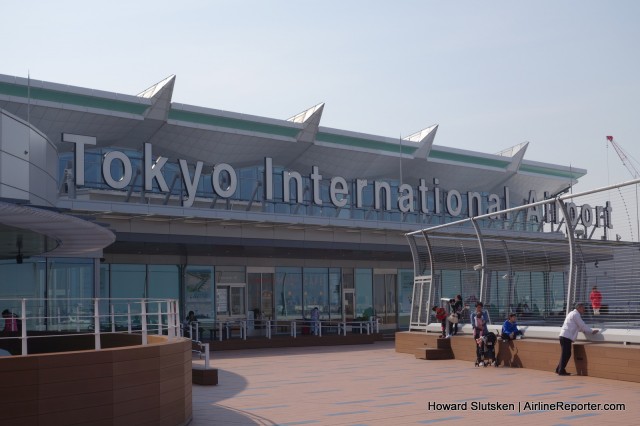
On the observation deck of the International Terminal at HND
You’ve got to hand it to the Japanese; always coming up with pragmatic solutions to problems. You’re having a walk in Tokyo and you’re thirsty? Grab a cold bottle of water from the vending machines you’ll find everywhere. Rainy day? Open up the umbrella you’re carrying. Just like most everyone else’s, it’s see-through, so you can make your way through the masses on the sidewalks without bumping into anyone. Simple. And those are just two of the countless observations I made during my blindingly fast visit to Tokyo.
If you’ve followed my stories, you’ll know that I traveled to Tokyo on ANA-All Nippon Airways’ inaugural flight from Vancouver (YVR) to Haneda (HND). There was a gate event at YVR for the inbound flight, ANA’s first-ever service to Canada. My flight to Tokyo was great, and then I was honored to watch ANA’s New Employee Ceremony in a hangar at HND, with ANA’s last 747-400D as a backdrop.
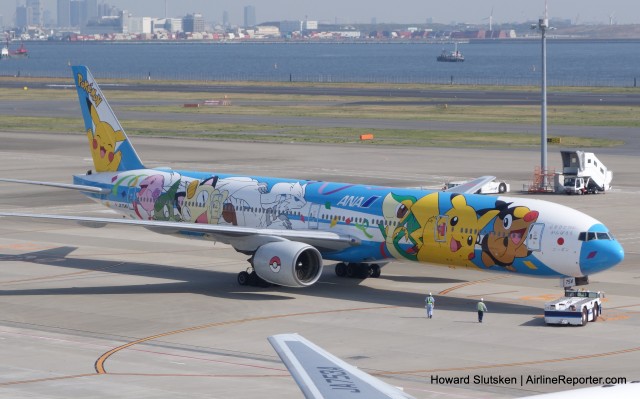
ANA 777-300 “Pokemon” pushes back from the gate at T2, HND
It was Tuesday afternoon, and I had split off from our media group to explore HND. I had heard that there was great plane spotting, and I wanted to see what the Japanese airport designers had done in the terminals. But first, a bit of background and a look at the layout of HND.
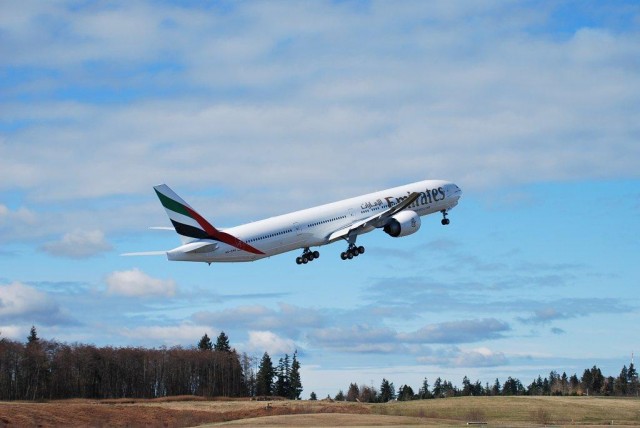
An Emirates Boeing 777-300ER – Photo: Emirates
In October of 2013, Emirates Airline became the first “Fifth Freedom” carrier to fly between New York City and Milan in Italy. This allowed a stop between New York and Dubai in the Italian city would help to increase services between not only Italy and Dubai, but also the United States and Italy.
Unfortunately, that service has barely been in operation seven months, and Emirates has come under fire from competing airlines, leading to the possible cancellation of the route.
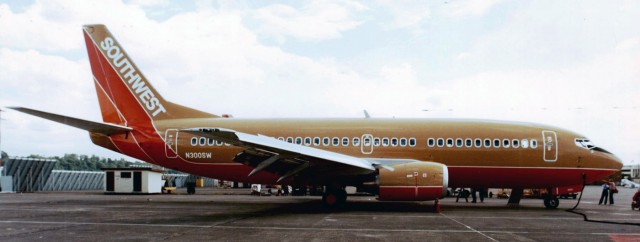
On November 30, 1984, Southwest took delivery of its first Boeing 737’“300, N300SW. It is now preserved at the Museum of Flight at Dallas Love Field. Photo: Boeing
Earlier this year, Southwest Airlines announced a significant number of new direct flights originating from their home base of Dallas Love Field. The newly-announced flights will provide non-stop service to places such as New York, Los Angeles, Denver, and Atlanta.
But why is Southwest, which has been in business since 1971, just now adding these seemingly universal routes to its network? To answer that question, we’ll have to go back in time and brush up on our Dallas-area airport history.
Prior to the opening of Dallas/Fort Worth International Airport (DFW) in 1974, the two cities had a history of contentious competition and missed opportunities. The first was a proposed joint airport way back in 1927. Fort Worth declined the proposal, opting to purchase and operate its own airport independent of Dallas. This led Dallas to build its own airport as well. The end result was the opening of both Love Field (in Dallas) and Meacham Field (in Fort Worth) to commercial air traffic.
In 1940, there was another attempt to cooperate in the construction of a regional airport for both cities, but it was eventually abandoned after neither city could agree on the location or details of the airport. This was followed by the creation of Amon Carter Field, later renamed to Greater Southwest International Airport (GSW), which was barely a stone’s throw away from Love Field.
Finally, in the early sixties, the FAA made it clear to the two cities that it wouldn’t invest any additional money into separate Dallas and Fort Worth airports (quick geography note ’“ downtown Dallas is roughly 30 miles from downtown Fort Worth). This, along with a directive from the Civil Aeronautics Board (CAB), finally pushed Dallas and Fort Worth together in an effort to develop a single large airport to serve the entire metroplex.
Thus, DFW was born.

![Photo and Press Release from Boeing... SEATTLE, Feb. 11, 2014 /PRNewswire/ -- Boeing's [NYSE: BA] passenger-inspired 737 Boeing Sky Interior marked its 1,000th milestone delivery with Norwegian Air Shuttle ASA. The 737 Boeing Sky Interior features modern sculpted sidewalls and window reveals, LED lighting that enhances the sense of spaciousness and larger pivoting overhead stowage bins. "The Boeing Sky Interior is delighting passengers and our airline customers," said Beverly Wyse, vice president and general manager, 737 program, Boeing Commercial Airplanes. "It's adding even more value to the Next-Generation 737, which already delivers the best economics, reliability and fuel efficiency in its class." Norwegian Air Shuttle was one of the launch customers for the 737 Boeing Sky Interior. This is the airline's 48th Next-Generation 737-800 with the new interior, making it the largest airline operating with the 737 Boeing Sky Interior in Europe. "Our goal is to provide passengers with the ultimate experience in comfort and convenience when they fly with Norwegian," said Bjorn Kjos, chief executive officer of Norwegian Air Shuttle. "The Boeing Sky Interior on the Next-Generation 737 helps us to deliver just that." A passenger survey conducted by Norwegian Air Shuttle soon after the airline began service with the new look found that more than half of respondents rate the 737 Boeing Sky Interior more comfortable than the standard interior. And passengers reported they feel "happier" in the new interior. Since the first 737 Boeing Sky Interior was delivered in October 2010, more than 60 customers have ordered the new interior. Approximately 85 percent of Boeing's backlog of more than 1,900 Next-Generation 737s will be delivered with the 737 Boeing Sky Interior. The passenger-preferred interior will be standard on Boeing's newest family of single-aisle airplanes, the 737 MAX.](https://www.airlinereporter.com/wp-content/uploads/2014/02/Norwegian_BSI-640x427.jpg)



